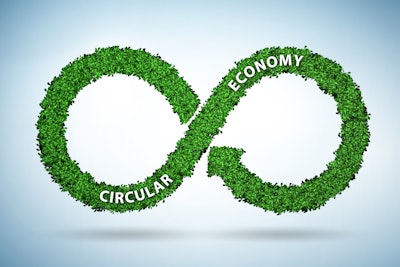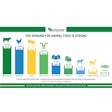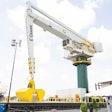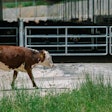
With circular economics a growing topic under the umbrella of sustainability, experts recently explored the role of circularity in the future of feed production.
The subject was the focus of the panel discussion, “How circular economics reduce waste in feed production and enhance animal nutrition,” presented at the 2024 Feed Mill of the Future Conference during the International Production & Processing Expo (IPPE) in Atlanta.
Panelists Dr. Christos Antipatis, global SMT additives director, Cargill Animal Nutrition, Michaela Braun, senior liquid systems and sales specialist, Novus; and Maye Walraven, North American general manager and chief impact officer, Innovafeed, covered topics including technologies and techniques that can improve feed production’s efficiency and bottom line.
 Photo by Paul Ward
Photo by Paul Ward
Circularity is based on the concept of reduce, reuse and recycle, and focuses on the goal of repurposing and eliminating waste, therefore improving environmental sustainability. Feeding human food waste to insects that will break down that waste and then using the insects in animal feed to produce protein that will then feed humans is an example of circularity.
“Circularity is not a new concept. It makes a lot of sense to try to extract value from all parts of resources,” Walraven said. “But I think it’s becoming more of a trend or more of a priority because we are feeling environmental pressure.”
Braun pointed out that the concept of circularity has been around for decades, if not longer, but has improved over the years.
“Historically, if we look at feed, we can go back 50, 60 years and we were feeding pigs and chickens scraps from the table,” she said. “That’s a very boiled-down version of circularity, but it is what we’re doing. We’ve improved upon that, nutrition has improved upon that, we’re still using byproducts of the human food industry, but I think there’s more ways that we can kind of extract more nutrition, more performance out of the animals.”
Walraven said that, as an insect producer, Innovafeed was inspired to build upon processes that occur naturally and improve upon it.
“We kind of took our inspiration through nature and, in nature, insects really act as a super upcycler,” she said. “They will feed on this very low-quality biomass that other animals won’t eat … and so we’re really trying to reproduce that on a large industrial scale where we grow insects and we tap into very large stocks of byproducts that are available.”
The insects are then used as feed ingredients, including oil and protein, as well as even the insects’ waste products as a fertilizer.
The value of feed additives
Feed additives are an important factor to improving the sustainability of feeds and reducing waste, as well as improving animal health and welfare, Antipatis said.
“I cannot think how we would operate today without feed additives. Nutritional and zootechnical additives are important to meeting nutritional demands. Without them, the animals will have to eat for longer and also will have to produce a lot more waste,” he said.
By utilizing feed enzymes, more nutrients are available from the same feed. Additives such as probiotics, prebiotics and phytogenics can optimize gut health, which is important to overall health and welfare of the animals. Food safety and quality can be improved through the use of mycotoxin binders, and other additives can lower ammonia and methane emissions.
Performance is “the first factor of improving sustainability because if you can feed the animals with less ingredients, you’re ultimately reducing the amount of pressure on the planet,” Walraven said.
How can those performance indicators be measured? By using artificial intelligence (AI) that can analyze the data collected and making decisions based on that analysis.
“Our objective here is to balance sustainability with affordability,” Antipatis said. “Analyzing all of inputs so we can understand what goes into diet, in the formulation. … We talk about nutrient supply and nutrient demand, making responsible decisions based on the outcomes we want from a production point of view, but also the lifecycle analysis – it is very important so we can look at the environmental goals. Now we can formulate for that goal as well. And finally farm monitoring – understanding the data, the AI to help … and, of course, interventions to achieve the objectives we have.”
Automation, AI can improve feed mill efficiency
AI can also be used to improve efficiency at the feed mill, as well as fill in some of the gaps created by labor shortages.
“Let’s use our automation, let’s use AI, let’s let our computers train themselves to a point that it takes the pressure off of us so we don’t have to be sort of perfect or worry about the human element of that,” Braun said. “I think it’s an important recognition that our workforce is changing, and it’s getting harder to staff feed mills, so we can use tools like AI or automation to help our scales, help with NIR, anything like that. I think that the world is changing in a way that it’s trying to help us as far as technology goes.”
Other small changes can also add up to increase feed mill efficiency and reduce waste, she added.
“We can do smaller things every day,” Braun said. “Let’s focus on our CGMPs (current good manufacturing practices), let’s quite literally do little things every day that will reduce a lot of the waste and I think with that come more opportunities because when you reduce your waste, well then we’ve got a little more wiggle room, other places to do bigger things that may help us in other ways. So I think that the small things can really do more than any bright, shiny, innovative thing that we can come up with today or tomorrow.”
Efforts to conserve energy, such as turning equipment off when it’s not in use, also reduces wear on components, saving money.
“It’s as simple as, when you leave a room, you turn the light switch off. That can apply to a lot of our equipment in feed mills and how we’re using them,” Braun said.
The panel discussion was moderated by Elise Schafer, editor of Feed & Grain.















